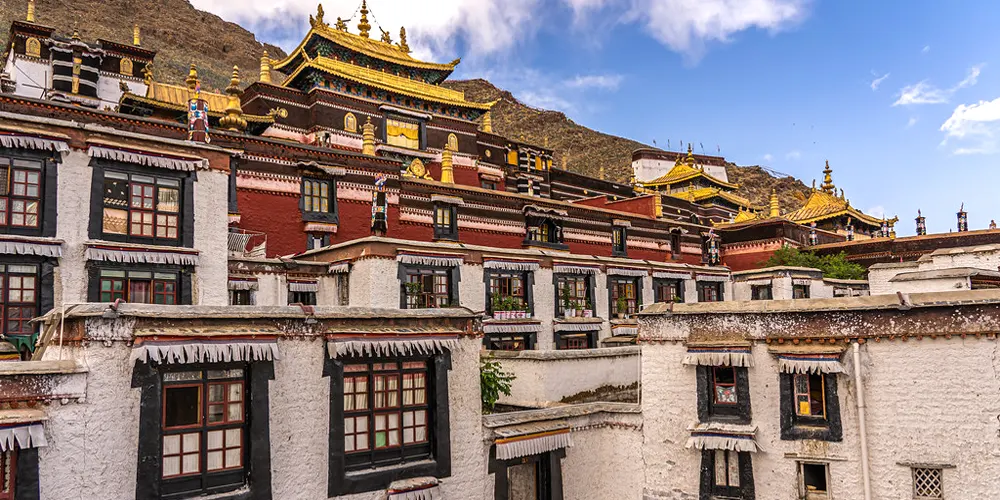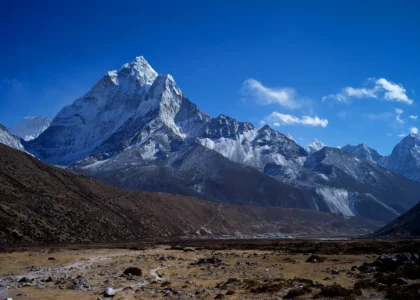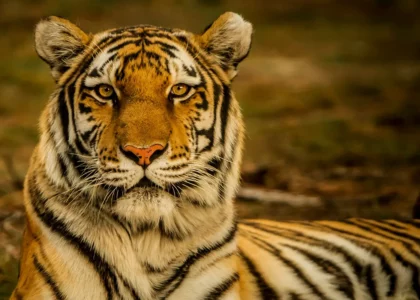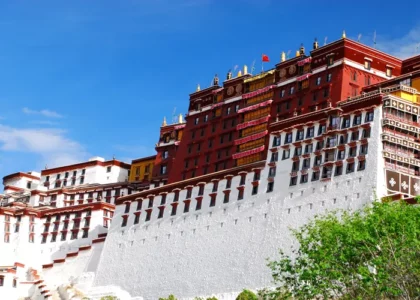Monasteries in Bhutan – Famous Monasteries to visit

Bhutan has a world of wonder within itself. Those who have traveled to Bhutan or been there at least once or twice know the uniqueness of the country’s architectural style, culture, traditions, and religious factors. While many neighboring countries to Bhutan have similar values and spiritual beliefs, some aspects of the country still stand out, including the monasteries there. Since the people there are very spiritual, you are likely to find monasteries in almost every other corner of the country. And this, in turn, becomes a gift to the onlooker’s eyes and hearts.
The various monasteries and their distinctive features make them all the more special than every other attraction you will find in Bhutan. Moreover, though similar to one another, different monasteries have their eccentric features, leaving a lot for visitors to explore and discover in the country.
Make sure to read till the end of this article to know about some of the most famous monasteries in Bhutan!
Tiger’s Nest Monastery (Paro Taktsang) – the most popular Monasteries in Bhutan
Paro Taktsang, or the Tiger’s Nest Monastery, is one of Bhutan’s prominent and famous monasteries. This sacred monastery existed many centuries ago, but the history behind its location dates back even further. It is best known for preaching Vajrayana Buddhism.
The Tiger’s Nest Monastery is one of the thirteen tiger caves where Padmasambhava practiced Buddhism. He meditated in the cave for three months. Beliefs have it that the tantric Buddhist Vajra master, originally from India, had ridden the back of a tigress and went to the location(Paro Taktsang) to defeat a tiger demon. Several students of the great tantric guru also practiced with him in the tiger caves.
The monastery has much more significance than the story behind it. Over history, there have been many instances where it has broken down or been on the verge of destruction. However, regardless of how long it took for things to improve and for the monastery to be rebuilt or reconstructed, the holy temple always stood firm at its finest state after every destruction. In Paro Valley, the locals celebrate a festival called Tsechu every spring as a tribute to Padmasambhava.
Since the monastery is located among cliffs and is one of the most dangerous-looking places in Bhutan, trekkers come here not only for pilgrimage but also to unleash their adventurous spirits. You can easily hire a horse or a mule to carry your luggage to the monastery at a reasonably tall height from where you are to start your hiking journey.
Trekkers can also choose to ride the horseback to make their hike easier. It is, however, best for the visitors to make the journey on foot since you have more to discover, and you can move at your own pace while embracing the beauty of the outcome and the trail. The monastery is just as magnificent, and you will find yourself going from one interconnected temple to another on the cliffs. One can make offerings and learn about the significance of the sacred location from one’s guides during one’s journey after coming through every aspect of the same.
Tango Monastery – Best Monasteries in Bhutan
If you are near or in Thimphu, you should visit Tango Monastery. This location has a rich history and has stood firm for several centuries. Since it is close to Cheri Mountain, you can enjoy the viewround. The monastery has not been the same since its very beginning, though.
The temple’s founder was Phajo Drugom Zhigpo, and its formation dates back to the 13th Century. Again 1688, Tenzin Rabgye, the 4th Temporal Ruler, built the current monastery at the same place. Further, since Tano Monastery is closely related to Hayagriva, it is named after the same, which also translates to horse head, otherwise known as Tango or Tangin in Bhutanese.
Ngawang Namgyal, known as the bearded lama, meditated in Tango monastery. The Drukpa Kagyu School of Buddhism in Bhutan holds the temple’s authority. According to history, the tenth-level Bodhisattva, Avalokiteshvara, had revealed himself as Hayagriva at the monastery location.
Similarly, the monastery was built in the Dzong style, also commonly seen in other monasteries in Bhutan. The monastery was once a cave where several great monks lived for prolonged periods.
You can also find prayer wheels with slates full of engraved letters. Tango Monastery is also filled with the aroma of butter lamps lit by the visitors and the monks there. Yarney is a summer festival that celebrates the seasonal retreat of the monks every year. Seeking great merits out of the festival, the monks in yellow robes eat right out of begging bowls and do not indulge in anything that would entertain them, even on holidays. Bhutanese locals offer these monks food as well.
Kyichu Lhakhang Monastery
Among some of the oldest temples or monasteries you will likely find in Bhutan, the Kyichu Lhakhang monastery has to be the oldest. Tibetan Emperor Songtsen Gampo, the 33rd King of the Yarlung dynasty, ruled Tibet for several years in the first millennium. He founded Kyichu Lhakhang Monastery, which stands firm and has welcomed visitors and pilgrims worldwide. Since Padmasambhava is said to have visited the monastery several times, it is believed that he had hidden many spiritual treasures here.
A historical belief about the temple is that its primary purpose was to summon a demoness called Sin Mo. The 108 temples were built daily to put the demoness on hold, enforce Buddhism, and spread Buddhism. When King Songtsen Gampo built the temple, it was much smaller than its present form. Without disturbing the original structure, many Buddhist gurus and monks contributed to the temple, finally leading it to become what it is today.
The monastery is fascinating, with several inscriptions written in brass and many paintings and architectural marvels you may find inside and outside the temple. You will be surrounded by peace and serenity when you’re here because not only is the environment peaceful, but the aura of the place fills your heart with great comfort.
Rinpung Dzong Monastery
Rinpung Dzong, or Paro Dzong, is one of the largest Dzong monasteries in Bhutan. Located in the Paro District, the monastery belongs to the Drukpa Lineage of the Kagyu school. It has facilitated both the Monastic Body and government administrative offices of Paro Dzongkhag. The sacred temple is also on Bhutan’s Tentative List for UNESCO inclusion. Drung Drung Gyal was offered the crag of Hungrel by the locals of Paro Valley back in the 15th Century. He was also the descendant of Phajo Drugom Zhigpo.
Later in the 17th Century, the crag of Hungrel was again offered to Ngawang Namgyal, the Zhabdrung Rinpoche. He was best known among the locals of Bhutan as the religious authority. He was the one who set the foundation for a new Dzong there. The formerly known Hungrel Dzong was reconstructed and is now known as Rinpung Dzong. Ever since the name and monastery have remained constant.
An interesting fact about this monastery is that it was also the prime location to shoot the 1993 hit movie The Little Buddha. Tsechu is a famous festival celebrated at the Rinpung Dzong monastery. This festival is celebrated according to Bhutan’s lunar calendar.
The procession takes place in the most traditional and old-fashioned way possible. This festival is quite possibly one of the most unique ones you will experience as a visitor to the country. Padmasambhava, the great tantric guru of Vajrayana Buddhism, is significant among the believers in this monastery. A dance performed in Tsechu by monks, representing the eight manifestations of Padmasambhava, including Gurus Nima Yoezer, Pema Jungney, Tshoki Dorji, Shacha Singye, Guru Pema Gyalpo, Guru Dorji Drolo, and Guru Loden Chokse.
As a traveler, the best factor besides the monastery is the magnificent view. From a certain height, you will see the greenery and the beautiful majestic monastery among the hills. Likewise, the evening view of the monastery is stunning, paired with the refreshing air and aura of the surroundings. The experience of every other visitor in the Rinpung Dzong Monastery will be no less than you may see in a dream.
Memorial Chorten
The Memorial Chorten, or the Thimpu Stupa, is in the capital city. Therefore, you will most likely be able to visit the monastery sooner than any other monasteries on this list, given that you will land in Thimpu first. The memorial is impressive with its green surroundings and nothing but the clear blue sky above it. This location has been guarded exceptionally well to this day. Therefore, few places will give you the vibe of uniqueness and inspiration that this one does.
This memorial is one of the newer ones in Bhutan. Many travelers and locals tend to use it as a landmark. It was built in 1974 as a tribute to the third Druk Gyalpo, Jigme Dorji Wangchuck. The memorial’s architectural style is much different from the regular Dzong-style monasteries you will find in abundance in the country.
Since the Druk wanted to build a memorial that reflects Buddhism and the mind of Buddha, the monument was established right after his death. Hence, it is not dedicated only to Buddhism but also to the vision of the Druk himself. You won’t find any figures or symbols inside the landmark but a picture of Jigme Dorji.
It is also one of the most visible memorials of Thimpu. And it is more popular than any other monument in the country. Memorial Chorten is built in a pyramidical style. A unique feature of the religious building is that you are going to spot immense images of angry deities with their female consorts, as well as explicit Yab-Yum sexual poses. There are around 36 such pictures. One is also to only circle the Chortens in a clockwise direction due to some strict religious beliefs in Buddhism.
The Je Khenpo blesses whoever congregates in the festival of Monlam Prayer, which is celebrated with great joy every year.
Kurjey Lhakhang Monastery
The Kurjey Lhakhang Monastery is one of the most prominent ones in Bhutan. This monastery is shaped like a Dzong-style house. Hence, it does not resemble any other monasteries in the country. However, this religious site’s significance is as vital as any other place. It is situated in the Bumthang Valley of the Bumthang district.
Padmasambhava is believed to have left a Tema, or a compilation of different spells and secrets of Vajrayana Buddhism, behind a monastery tree. The locals regard this temple as essential and carefully conduct themselves in and around the site.
The history of the location where this monastery is placed dates back several centuries to when it was the ruling time of Bumthang’s emperor Sindhuraja. The King had made several attempts to grasp the attention of the local deities to save his son in the battle. However, his son succumbed to the struggle, making the King extremely angry with the deities. This further pushed him to act against the deities and angered a strong local deity called Shelving Karpo. As a curse, the deity punished the emperor for slowly suffering from illness with the help of a potent spell.
The King’s helper went to Padmasambhava, who was in Nepal, to cure and save him from dying. The helper also offered him a bowl of gold dust for his favor. The great tantric guru was convinced and went to Bhutan to get a hold of the angry deity and restore life and health to the emperor. The condition of the King had been worsening by that time. Sindhuraja promised to give Padmasambhava whatever he wished for in return for his cure. The guru then asked for his daughter’s hand upon completing his mission.
At first, Padmasambhava failed to lure and subdue the local deity with his dance. Although it may have attracted the attention of several other local deities, it did not have a single effect on the one he had been targeting. Eventually, the guru asked the helper to fetch water from Kurjey Drubchhu, which helped him succeed in luring and subduing the deity.
Once again, with much devotion and wit, Padmasambhava secured his goal of curing the King. He even meditated for a reasonable time in the cave where the deity was subdued. The monastery was named after the source from which the holy water was fetched.
The palace-like monastery looks like one since it has been the resting place of three Bhutanese kings. The tallest tree at the back of the monastery is also believed to be Guru Rinpoche’s walking stick. The sacred building is amidst much greenery, keeping your mind and body at peace. Taking rounds inside and outside the temple can be a therapeutic experience for every visitor.
Tamshing Lhakhang Monastery – the most visited monastery in Bhutan
Tamshing Lhakhang Monastery, or Tamshing Lhündrup Monastery, is a famous monastery in the Bhutan Bumthang district. This temple is directly connected with Pema Lingpa and his disciples, making it all the more significant among Buddhist followers worldwide. Currently, the monastery is the seat of Sungtrul Rinpoche, also known as a reincarnation of Pema Lingpa.
The monastery is among the tentative list in Bhutan and has also been submitted as an inscription on the role of World Heritage Sites. Additionally, the temple is highly cramped with old temples and has been famous as a vihar, home to several monks. It has been operating that way for several years now. There are at least 95 Buddhist monks living in the vihar.
Tamshing Lhakhang Monastery has seen several changes since it was established long ago by Pema Lingpa in 1501. The great Ringpochhe died in the monastery within the same Century. The Buddhist monks have found a place for themselves in the temple. The monastery and the temples have been renovated and enlarged since their founding. Another interesting fact about this religious site is that Pema Lingpa developed the foundation of the temples in the monastery because he found a spell that Padmasambhava had hidden around there.
Lopen Kharma, known as Khudun, came to the monastery as a 10-year-old monk. He later grew up to become the senior monk and the teacher of the monk disciples in the monastery. Kharma is still in the temple, serving his bit to this day. The Lama Sungtrul Rinpoche, also known as the 11th reincarnation of Pema Lingpa, is the spiritual head of the monastery at present.
When you visit the monastery, you will be able to experience the beauty of the surroundings, explore the traditions that have long been since its foundation, and learn about the life of the simple monks living under the teachings of the most learned monk in the country.
During the Tsechu festival, visitors can view the Tamshing and other Bhutanese dances, which are to be performed correctly by the Bhutanese monks. Likewise, either of the dances holds great significance and must be performed carefully to respect the art that has been around for the longest time known. The Buddhists tend to take the dance forms as one that relieves the mind and forms an essence of the beautiful religion that Buddhism is.
Punakha Dzong Monastery
Another famous Dzong monastery in Bhutan is the Punakha Dzong Monastery. This monastery, Pungthang Dewa chhenbi Phodrang, translates to a palace of bliss and happiness. It is the second-largest and second-oldest monastery in the country. The holy temple has a rich history; even the royals throughout Bhutan have a significant role.
Legends have it that the architect of the monastery had seen a dream after the Zhabdrung ordered him to sleep under a tree. He dreamt of building a small Dzong with a small statue of Buddha. The vision of the temple had been imprinted in the architect’s mind. In his dream, he felt blessed by the power of Guru Rinpoche, which inspired him to take action immediately. Within a year of getting started, the monastery was completed in 1638.
The monastery later served as a commemorative chapel for the Tibetan soldiers whom the Bhutanese soldiers had defeated in the location. Moreover, the 7th Dalai Lama donated the roof of the Dzong as well.
While there have been several changes in the size and make of the Punakha Dzong Monastery over the years, many dangerous incidents, like fire and earthquake, have brought about negative changes and damage to the building. The Dzong, however, has managed to stand firm amidst the terrible accidents that have taken place in the past many years. After the monarchy of the Wangchuk family, the monastery was also under the authority of Sir Ugyen Wangchuck, Druk Gyalpo, who had also been crowned there.
Visiting the palace or the monastery will transport visitors to a long-existing reality. The walls of the holy building tell several stories, and the surroundings are just as peaceful. Going there for a visit will serve as an experience many might not have in any other location, even in Bhutan.
Lhuentse Dzong Monastery
The Lhuentse Dzong in the Lhuentse district of Bhutan is a precious monument with rich significance in the country’s religious history. The monastery has not always been known by its current name. In the formerly isolated location, it was famous as Kurtoed. Long before the Dzong was officially declared solely a monastery, it was the ancestral house of the royal family, the Wangchuks. It was also the place where Dasho Jigme Namgyal was born in the 1800s.
Since the monastery has rich cultural roots in the royal family, it is also known as a landmark of Bhutanese culture and history. It is said that the son of Pema Lingpa, Khedrup Kuenga Wangpo, was asked to fetch a ridge that looked like an elephant’s trunk. On this journey, he found a location called Kurtoed Lhuentse Phodrang.
He even spent a while meditating there. Finally, in 1543, he established the monastery. Governor Minjur Tenpa won a battle much later, and he was the one to name the religious building Lhuentse Dzong. Later, with time, it also became the house of the Wangchuks. However, since the royalties shifted to another location for residence, the monastery has now become the residence of over 100 Buddhist monks.
Padmasambhava also plays a significant role in building the monastery’s religious significance. The site contains five temples, three dedicated to the tantric guru. A Gonkhang in the location is also made as a dedication to Amitāyus or the Buddha of Infinite Life. Unfortunately, the most recent history of the temple, which dates back to 2009, had seen a disastrous earthquake that caused much damage to the ancient monastery.
Besides the exciting history of the monastery, you can enjoy the fantastic view around the monastery. The building is not located in an urban area but amongst the hills and greenery, which makes visiting the site all the more refreshing and serene. You will be welcomed by a rather ancient building that has seen so many stories from the past to this date. The aura of the building, the interiors, and the content are enough to keep one invested as they keep exploring the location. If you are to visit Bhutan, it would be a loss not to see this monastery.
Jambay Lhakhang Monastery
A prominent monastery that is age-old yet holds much significance and has been standing strong throughout the passage of centuries has to be the Jambay Lhakhang Monastery. The temple is also famous as the Temple of Maitreya or the Jampa temple. It is also located in the Bumthang district. The monastery consists of 108 temples that King Songtsen Gampo had built. There is a saying that the entire place was constructed within a single day. According to ancient beliefs, the whole point of having built the monastery was to bury a demoness deep into the earth’s body forever.
Again, Padmasambhava has a significant role in forming the Jambay Lhakhang Monastery. The monastery has been destroyed and rebuilt several times throughout history. However, the temple’s significance dates back to when the tantric guru healed King Sindhuraja from the curse of an angry deity.
After restoring his health and life, the King devoted his efforts to dedicating the monastery to Padmasambhava. The site did not quite look the way it does in the current time when it was first built. But, it would be fair to say that it still has not lost even a bit of its religious and spiritual essence today.
Likewise, anyone visiting the Jampa temple will fall in love with the architectural style and the temple’s surroundings. The monastery looks much like a house as of now. Several buildings, which are all part of the religious site, house monks who have devoted their lives to Buddhism and the pathways led by the religion’s ancestral idols.
When you visit the monastery, you will find yourself immersed in the rich traditions and spirituality of the monks, as well as the Buddhist locals and pilgrims who live and visit the site. The site is also full of sacred murals, paintings, and small temples, which may number around 108. Overall, visitors will surely enjoy the adventurous and religious journey to one of the most important monasteries in Bhutan when they visit Jambay Lhakhang.
Conclusion
It would be an understatement to say that Bhutan is the house of the world’s most unique history. With the blend of Buddhism and a bit of Hinduism, many religious stories lie within the walls of all the monasteries and temples above. Every other monastery holds its unique set of stories and significance, which mandates that visitors not only go to one or a few but also explore as many monasteries as possible. Similarly, the architectural style of the buildings is just another factor to marvel at.
Best Price Guaranteed, Easy to change Date, Instant Confirmation
Book This Trip Have Questions?
Have Questions?Talk to Expert
Meet Mr. Purushotam Timalsena (Puru), Nepal's best trek and tour organizer, who has been working in the Himalayas for more than 24 years.
WhatsApp/Viber +977 98510 95 800











